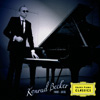Konrad Becker, "Grand Piano Classics"
 Preserved for posterity as four-track tape recordings, Konrad Becker’s Piano Concertos for 4 Pianos have finally crossed the digital divide. While the man behind the music has been anything but listless, these recordings have until now, laid fallow for upwards of 25 years, making this the first release of his acoustic music. Originally used for the performance series Program for the 100% Resocialization of the Devil in 1982-83 and the experimental opera Parzival in 1984, the pieces are redolent with low-end perfumes, thick metallic fogs, and percussive walls of splendor. The simultaneous play of four roaring pianos creates music rife with subterfuge and illusion.
Preserved for posterity as four-track tape recordings, Konrad Becker’s Piano Concertos for 4 Pianos have finally crossed the digital divide. While the man behind the music has been anything but listless, these recordings have until now, laid fallow for upwards of 25 years, making this the first release of his acoustic music. Originally used for the performance series Program for the 100% Resocialization of the Devil in 1982-83 and the experimental opera Parzival in 1984, the pieces are redolent with low-end perfumes, thick metallic fogs, and percussive walls of splendor. The simultaneous play of four roaring pianos creates music rife with subterfuge and illusion.
Konrad Becker is a High Magistrate of Hypermedia. A polymath involved in numerous interdisciplinary fields of study and endeavor. His energies have previously been focused on his work as director of the Public Netbase from 1994 to 2006. More recently he has started the World-Information Institute. With these groups he has organized several conferences and symposiums. He is the author of Strategic Reality Dictionary: Deep Infopolitics and Cultural Intelligence and co-editor of Critical Strategies in Art and Media: Perspectives on New Cultural Practices both published by Autonomedia. Music fans will know him for his accomplished forays in electronic and computer music under the name Monoton, a project that begin in 1979. The acoustic works on this album expose another facet of Konrad’s complex working methods, and his fascination with mathematical structures.
The songs on the two-disc set are not arranged sequentially. Two of the long players, both over 40 minutes, preclude that possibility. Disc one opens with "Parzival Overture" from 1984, moving in a non-linear manner afterwards.The song is thunderous and dense, and all four pianos are multi-tracked, played by Konrad. He hits the notes in rapid fire succession, a characteristic that the other concertos share as well. Resonating overtones give wings to the imagination. All smashed up into a thick wall of sound, it seems as if the notes spent some time together in the Large Hadron Collider. The rhythmically vibrating strings cause me to lock in step and oscillate at the same high rate. The manner of playing focuses on the percussive element and is akin to a shaman beating on a frame drum to induce out-of-body journeys and it would not surprise me if this was also Becker’s intention. Many of his live performances and installations incorporated field recordings of Shamanic music from various corners of the globe, and his writings espouse a deep concern with the traffic of the internal world. The monotonous minimalism of the overture is made functional in this manner while remaining aesthetically pleasing. In its last ten minutes as it progresses towards a conclusion the tempo slows down, allowing the notes to unglue themselves from each other and be heard distinctly in their own right. When the song concludes I feel as if I have been traveling and am finally allowed to take a moment and catch my breath at a rest area. Except the songs bleed into one another without any break or pause. I would have liked a pause.
"Noctariations" follows. As the title implies the music emits an aura of cloudy dreams, perfect for the dark hours of night. In this piece the strings rattle with a clangorous glee, buzzing as if the piano has been prepared with pieces of metal laid across the strings. All the while a luscious drone permeates the background, and I wonder if he ever let his foot off the sustain pedal. "Etude" has the quality of one of William Basinki’s Disintegration Loops. From 1982, I can almost hear the grit, dirt, and decay that seem to cling to the reels of magnetic tape. "Danse Diable" from 1983 takes up the major portion of the second disc, clocking in at nearly fifty-minutes. Polychromatic time signatures veer off in different directions. Quantum entanglement, however, ensures that the sounds remain aligned. A dense reverberation forms a magnetic undercurrent beneath the notes that are playing in a higher register. This effect gels it all together.
The release also includes three Zero Oxygen Bonus Tracks, composed in 2002 as a digital epilogue to the other four songs. Two were included at the end of the first disc and the third on the second. The digital piano mixed and looped with dance floor beats sound fun and playful. These quirky tunes would be at home at any large outdoor electronic music festival, making an excellent addition to the album. I only wish that all three were placed back to back on the second disc where there was plenty of room for them. This would have allowed for a more streamlined listen. It also would have been nice if the acoustic pieces had been mixed so as to fade out a bit at the end of each song. The abrupt endings and transitions tended to jar me out of my listening trance. Minor grievances aside, Klanggalerie has done another fine job releasing and preserving crucial artifacts.
samples:
 



